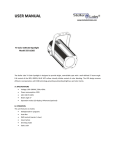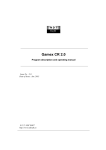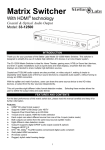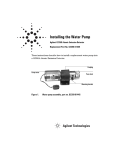Download 150P Operator`s Manual, Old Style
Transcript
150P OPERATING INSTRUCTIONS SYSTEM OVERVIEW The 8”x10” Manual Film Processing system is a lightweight, portable, self-contained system which produces finished, high quality, positive radiographs without conventional wet processing or a dark room. The components which make up the system are the 150P processor, film positive and negative, and the cassette with intensifying screen. The 150P film processor contains no processing chemicals and requires no electricity to operate. The 8”x10” Polaroid® cassette Model 85-6 or 85-7 may be used with the 150P. Both cassettes feature a built-in rare earth intensifying screen and a pressure plate which maximizes film/screen contact evenly over the film surface. Polaroid® TPX and 803 films consist of a light-sensitive negative in a light-tight envelope, and a positive imaging sheet with an attached pod of processing chemicals. An exposed negative (held in the cassette) and a positive sheet are fed through the processor rollers together, breaking the pod and spreading processing chemicals over the image area. After the recommended processing time, the film is peeled apart and the negative discarded. The positive sheet is available for immediate viewing. PREPARE FILM CASSETTE 1. 2. 3. 4. 5. 6. 7. 8. Press the two blue buttons on the back of the cassette and open it flat. (Figure 1) With the printed side of the negative up and the three arrows pointing away from the orange tongue of the cassette, place the negative into the cassette. Slide the negative so the fold underneath hooks securely onto the orange tongue of the cassette. Correctly positioned, the packet will extend slightly beyond the edge of the cassette. (Figure 2) Be sure negative is centered between the two blue guide lines. Close the cassette making sure both buttons latch shut. Leave the envelope in the cassette until you are ready to make an exposure. This will help prevent light leaks. (When loading several cassettes at once it will also help you distinguish between exposed and unexposed negatives.) Remove the envelope by grasping it at the arrows with one hand and holding the cassette with the other. Pull the envelope straight out of the cassette. Lay the silver side of the cassette down on a flat surface and depress the pressure plate on the back of the cassette until all four locks are locked into position. Figure 1 Figure 2 LOAD THE POSITIVE 1. Open the 150P processor so both sides laying flat. (Figure 3) 2. Place the film positive in the processor as follows: - DO NOT bend the positive when inserting it in the processor. (Figure 4) - Pods on positive face up. - Slide the end of the positive with pods under all metal parts in the processor until you feel resistance. (Figure 5) - Pull the positive back so the paper tabs on the positive are under the processor spring clips. (Figure 6) - Press down on the aluminum plate and look in the processor. The metal tongue should be under the paper flap on the positive. (Figure 7) If the metal tongue is over the paper flap the rollers will not pull the positive through the negative. Figure 3 Figure 4 Figure 5 Figure 6 Figure 7 EXPOSE FILM IN CASSETTE TO AN X-RAY SOURCE 1. 2. 3. 4. 5. Place the cassette containing the film negative directly behind the object to be X-rayed. Place the X-ray source 2-4 feet in front of the object. The cassette should be in the center of the X-ray beam and perpendicular to the X-ray unit. Make sure all personnel are a safe distance from the X-ray source. Turn the X-ray unit on, select the desired number of pulses, and fire the unit by depressing the time delay button or remote cable button. LOAD THE CASSETTE WITH EXPOSED NEGATIVE 1. 2. 3. Take cassette with exposed film and release the pressure plate by depressing pressure release bar located next to the film tab. (Figure 8) With the silver side of the cassette facing up, slide the end of cassette with protruding film tab into processor. (Figure 9) Grasp both sides of the processor. Using your thumbs, slide the cassette as far as possible into the processor. The back edge of a properly inserted cassette will be about ¼ inch in from end of the processor. Figure 8 Figure 9 DEVELOP FILM 1. 2. 3. 4. 5. 6. Brace the processor by placing one hand firmly on the edge of the processor closest to the crank arm. (Figure 10) Do not brace the processor by placing hand over the cassette. (Figure 11) With other hand, turn the processor crank briskly and evenly clockwise four revolutions, or until crank resistance decreases. Wait 1 minute for the film to develop. Lift processor lid and remove the film. (Figure 12) Peel the positive and negative apart. If you are using Polaroid TPX film you should coat the radiograph to stabilize the image. CLEAN THE ROLLERS 1. 2. 3. 4. Clean rollers after every third print and before storing processor for next use. Open the bottom flap so the rollers are visible. (Figure 13) Use a damp soapy cloth, alcohol swabs, or travel type wash & dries to clean the rollers. Turn the crank while wiping down the rollers until the entire roller surface is cleaned. Figure 10 Figure 11 Figure 12 Figure 13 TROUBLE SHOOTING Black radiograph (no exposure) - Negative envelope not removed - Faulty generator (no X-rays emitted) Check X-ray emission either by dosimeter reading, or, in a dark place, fire the X-ray source at the screen of an opened cassette. (Screen will illuminate if source is working properly.) Radiograph too dark - Underexposed Clear radiograph (extreme overexposure) - Negative loaded backwards Radiograph too light - Overexposed Repeated dot pattern - Dirty processing rollers - Turned the crank the wrong direction Black specks - Dirty intensifying screen Blurred image - Pressure plate not locked or not fully locked - Subject or cassette in motion at time of exposure Poor image quality - Processing time to short - Unsuitable processing temperature Washed out image, gray cast over entire radiograph (chemical fog) - Positive sheet stored at high temperature Light area in a line on radiograph (light fog) - Light leak in processing chamber (keep processor out of direct sun while in use) Horizontal dark lines across radiograph - “Hesitation” marks caused by uneven roller speed or dirt on rollers Bits of developer adhere to radiograph - Positive peeled too slowly from negative (if possible, blot developer off carefully with paper towel immediately after separation) Negative envelope difficult to remove - Negative not loaded between blue guide lines in cassette - Negative loaded in cassette upside down - Operator not grasping envelope in center . or not pulling envelope straight out of cassette Negative and/or positive fails to pass through the rollers when hand crank is turned - Negative tab bent - Negative not loaded between blue guides in the cassette - Negative did not catch on orange tongue in the cassette when the envelope was removed - Positive not positioned correctly - Tongue in processor went over the paper on the positive instead of under it – (put a fold in the paper to create additional space between paper and positive.) - Bearing blocks in the processor that hold the rollers together broke (remove processor base to verify) - Processor spring clips that hold positive are bent incorrectly If multiple sheets of film fail to pass through the processor call Golden Engineering for assistance. LIMITED WARRANTY Golden Engineering, Inc. warrants each Processor 150P made and sold new by it or its authorized representatives to be free of defects in materials and workmanship for a period of 12 months from the date of shipment to the end user. To make a claim under this limited warranty, customer must ship the entire unit or component believed to be defective to Golden Engineering postpaid. Golden Engineering assumes no liability for units or components shipped until actually in the custody of Golden Engineering. Provided Golden Engineering, in its sole discretion, is satisfied that the defect is not the result of abuse, misuse, accident, modification or improper disassembly or repair, Golden Engineering will repair or replace the defective component or components at its own expense. Golden Engineering reserves the right to use reconditioned and remanufactured components which meet original specifications. The unit or component will be return shipped to customer at customer's cost. THIS EXPRESS LIMITED WARRANTY IS IN LIEU OF ALL OTHER WARRANTIES AND GUARANTEES, EITHER EXPRESS OR IMPLIED OR CREATED BY OPERATION OF LAW. GOLDEN ENGINEERING, INC. P.O. Box 185 Centerville, IN 47330 (765)855-3493 Fax: (765)855-3492
















